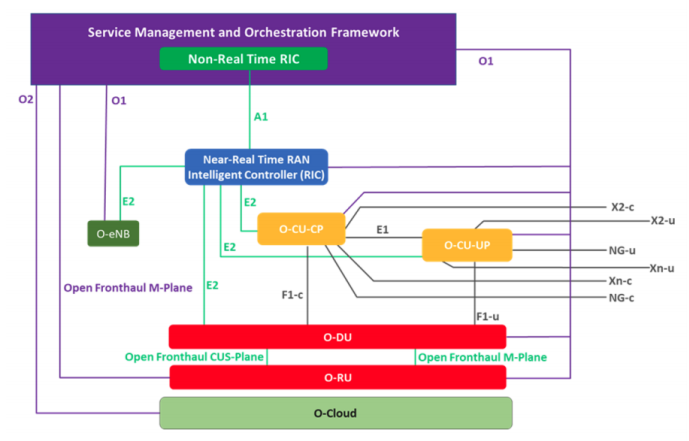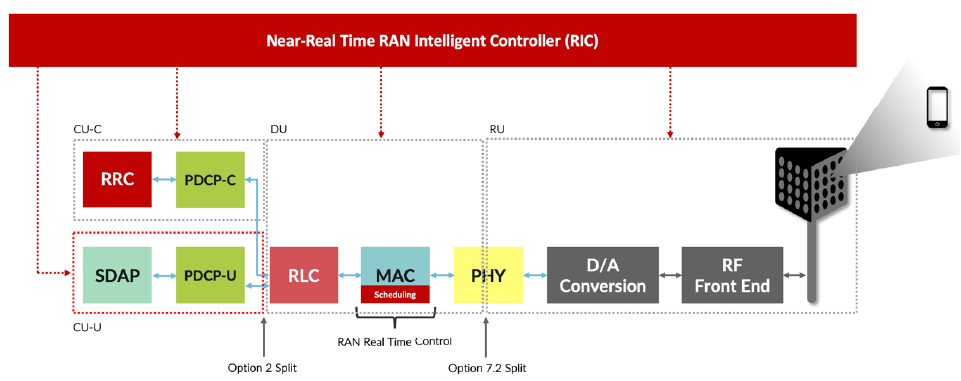The main motive for the RAN Intelligent Controller (RIC) is to bring software-defined controllability to RAN to increase system performance as on the path towards 5G, with network densification, and availability of different types of spectrum bands, it is increasingly a more difficult task to optimally allocate radio resources, implement handovers, manage interference, balance load between cells, etc.
The current radio resource management (RRM) control is distributed across the sites is not optimal and this can be achieved by decoupling the associated intelligence from the underlying hardware and protocol stack.
So we can say that We need bring more intelligence to the RAN domain
Now let’s see the 3GPP RAN split options that are selected by O-RAN Alliance to disaggregate the RAN functions into disaggregated components.
O-RAN describes the RU (called O-RU) as the logical node hosting Low-PHY layer and RF processing (e.g split option 7.2), the DU (called O-DU) as the logical node hosting RLC, MAC, and High-PHY layers (e.g split option 2), and the CU (called O-CU) as the logical node hosting RRC, PDCP, and SDAP layers.

And here we can see how the protocol stack is splitted between the disaggregated nodes (O-CU, O-DU, and O-RU) on the two splits Option 7.2 and Option 2 as below.

In the disaggregated RAN architecture, the RRM functions reside in the CU (in the RRC layer in the RAN protocol stack), and in the RU (in the MAC layer in the RAN protocol stack). Then, the decoupling of the RRM intelligence from the underlying stack software effectively requires:
- Disaggregating the CU into CU-U and CU-C.
- Clearly defining open interfaces between CU-C and CU-U, DU, and RU.
- Logically centralizing the RRM intelligence to run on a RAN-optimized SDN controller, called RAN Intelligent Controller (RIC).
As per ONF, The corresponding architecture that allows for software-defined RAN control is illustrated in the below figure

The main benefits of RIC
- Democratization of the innovation within the RAN: The control plane – user plane separation and open, clearly-defined interfaces between the disaggregated RAN components as well as between the RAN control and associated control applications, allow for innovative, third party control solutions to be rapidly deployed regardless of which vendors have provided the underlying hardware and software solution.
- Holistic control of Radio Resource Management: Software-defined control of RAN will allow for logically centralized (within limited-geography) control of radio resource management. Then, for a given active user, using innovative control applications, operators are empowered to conduct a dynamic selection of any radio beam within reach across all network technologies, antenna points, and sites using a global view that minimizes interference, and thus maximizes observed user quality of experience.
This can be achieved by applying carrier aggregation, dual connectivity, coordinated multi-point transmission as well as the selection of MIMO and beamforming schemes using a global view of the wireless network.
- Use-Case Based Management of the RAN: Software-defined RAN control will allow for the integration of performance-based decisions with policy-based constraints, with such constraints to be dynamically set, based on use cases, geographies, or operator decisions.
Conclusion
With the explosive ongoing demand in mobile connectivity via an ever-increasing diversity of end devices for a wide variety of use cases each with vastly different demands, the mobile network, including the RAN needs to be open, disaggregated, virtualized, software-defined controllable, and should operate using cloud principles. 3GPP and O-RAN collectively provide the interoperability specifications for this vision.
